Environmental studies 2000 - 2018

Authors:
L. D. Sivle, P. H. Kvadsheim , A. Fahlman, F. P. A. Lam , P. L.
Tyack, and P. J. O. Miller.
Abstract:
Anthropogenic underwater sounds in the environment
might potentially affect the behavior of marine mammals
enough to have an impact on their reproduction and
survival. Diving behavior of four killer whales (Orcinus
orca), seven long-finned pilot whales (Globicephala
melas), and four sperm whales (Physeter macrocephalus)
was studied during controlled exposures to naval sonar
[low-frequency active sonar (LFAS): 1–2 kHz and mid-
frequency
active sonar (MFAS): 6–7 kHz] during three field seasons
(2006–2009).



Authors:
Bart Shepherd, Matt Wandell, Hudson T. Pinheiro, and
Luiz A. Rocha
Accompanying the recent technological innovations in
remotely operated vehicles (ROVs), submersibles, technical
SCUBA, and closed-circuit rebreather diving gear, new
discoveries are being made on mesophotic coral
ecosystems around the world.
However, collecting live fishes from mesophotic depths
(60–150 m) is challenging, given the difficulty of accessing
the habitat, catching the fishes, and the barotrauma that
can result from rapid decompression during their
transport to the surface. The authors designed and tested
the performance of a portable, submersible hyperbaric
chamber, the SubCAS, which they used to safely surface
reef fishes from mesophotic depths.

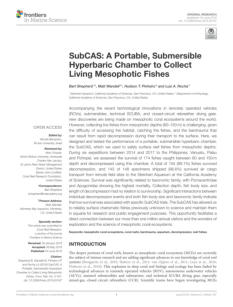

Authors:
H. A. Shiels, G. L. J. Galli, B. A. Block
Studies of how animals can adapt to their environment
are helpful to understand how humans can adapt in the
future.
This paper discusses studies regarding the capacity of
Pacific bluefin tuna to endure the thermal challenge,
which is partially due to the enhanced activity of proteins
involved in cardiac excitation-contraction coupling, which
improve its cardiomyocyte function (Cardiomyocytes are
cells responsible for contracting the heart, and the control
of the rhythmic beating of the heart), and thus the animal
performance during temperature change.

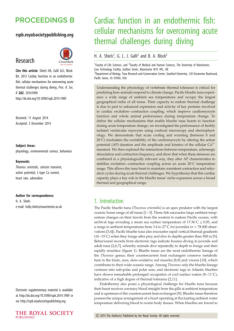

Authors:
Maja Berden Zrimec, Mojca Poklar, Dean Mozetic, Dusko
Vranac.
This document is a presentation of the challenges and
relevant techniques for underwater mapping using
photogrammetry.



Authors:
A. Fais, M. Johnson, M. Wilson, N. Aguilar Soto, & P. T.
Madsen
The sperm whale carries a hypertrophied nose that
generates powerful clicks for long-range echolocation.
However, how this apex predator catches its prey remains
a conundrum. Several hypotheses have been advanced to
propose both active and passive means to acquire prey,
including acoustic debilitation of prey with very powerful
clicks. In this paper, the authors test these hypotheses by
using sound and movement recording tags in a fine-scale
study of buzz sequences to relate the acoustic behaviour
of sperm whales with changes in acceleration in their
head region during prey capture attempts.

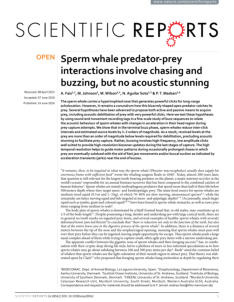

Authors: Gardenio Diogo Pimentel Da Silva and David
Alves Castelo Branco.
This paper gives an overview of the environmental
impacts caused by conventional and floating photovoltaics
systems with a particular interest in large-scale units. It
addresses and compares the effects at all phases of project
implementation, such as planning, construction,
operations, and decommissioning, focusing on ambient
located in the tropics.



Authors: Marco Ligi, Luca Cocchi, Giovanni Bortoluzzi,
Filippo D’Oriano, Filippo Muccini, Fabio
Caratori Tontini, Cornel E. J. de Ronde, Cosmo
Carmisciano
The authors present the results of recent geophysical
investigations of Marsili and Palinuro volcanic complexes
and the southern Tyrrhenian Sea during 2010 TIR10 and
2011 MAVA2011 cruises by the R/V Urania.





Authors:
G. Nyamadzawo, F. Mapanda, M. Wutaz. Nyamangara, P.
yamugafata and Z. Jiri
Disposal of wastes from sulphate mining operations has
been a perennial problem to the environment in many
countries, because these wastes usually continue to
produce acid mine drainage (AMD) for a long time after
the wastes have been generated.
The impacts of AMD include reduction in the quality of
water. This review is a synthesis of all the research work
that has been done at Iron Duke Mine (IDM) that extracts
pyrite minerals in Zimbabwe.



Author: James Everts
An estimated 20% of the global corals are threatened by
exposure to toxic substances. The main chemical threats
are pollution by oil and oil dispersants, industrial chemicals
from discharges, pesticides from run-off, antifouling
compounds, and chemical fishing practices.



Author: Stephane Le Floch
The chemical industry is today at the hub of the global
economy and must often overcome vast distances
between production and consumption areas. These
geographical constraints require large volumes of
hazardous substances to be transported, often by sea.
Shipping generates steadily rising risks due to the ever-
increasing size of vessels and the pressure of world
markets. In the event of an incident, these risks lead to
different problems than those encountered in the case of
oil spills. The threat of a chemical spill concerns many
stakeholders.



Authors:
Amelia S. Wenger, Katharina E. Fabricius, Geoffrey P.
Jones, and Jon E. Brodie
This paper reviews the direct and indirect effects of these
three forms of marine pollution on the behavior,
physiology, life histories, and communities of coral reef
fishes, and the potential consequences of altered fish
abundances for the ecology of coral reefs. Increased
sediment, both in suspension and settled, can directly
affect reef fishes by reducing visual and chemical cues,
disrupting the feeding of planktivores and herbivores, and
altering predator–prey interactions.

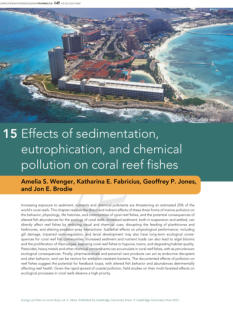

Author:
Albert Palanques, Josep Caixach, Marc Belzunces, and
Arantxa Bartolome
In 2000 and from 2006 to 2011, a monitoring program
was followed along the Catalan inner shelf, using
homogeneous analytical methods and sampling strategies
and focusing on the main sites of river sediment
accumulation. Adjacent areas that are potentially
vulnerable to pollution were also selected. Trace metals
and organic pollutants were analyzed in surface sediment
samples.



Author:
Ahmed Minhaz Farid, Alam Lubna, Ta Goh Choo,
Mohamed CheAbd Rahim, and Mokhtar Mazlin
Langat River, in Malaysia, is a significant source of drinking
water and development and needs special care to reduce
pollution. The Environmental Quality Report of the
Department of Environment from 1997 to 2013
addressed that the river possessed the status of class III,
which required extensive treatment before drinking.
However, more than one of the nine water treatment
plants in the basin had to remain
closed several times during 2012-2015 due to the high
concentration of chemical pollution in the river.

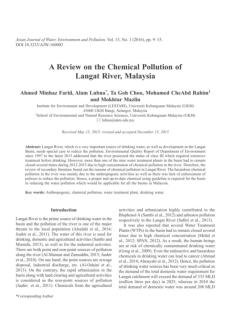

Authors:
A Gaida, O Holz, C Nell, S Schuchardt, Lavae-Mokhtari, L
Kruse, U Boas, J Langejuergen, M Allers, S
Zimmermann, C Vogelmeier, A R Koczulla, and J M
Hohlfeld
There is increasing evidence that breath volatile organic
compounds (VOC) have the potential to support the
diagnosis and management of inflammatory diseases
such as Chronic obstructive pulmonary disease, or COPD,
which refers to a group of conditions that cause airflow
blockage and breathing-related problems. This study used
a novel breath-sampling device to search for COPD-
related VOCs.



Authors:
N. Karkashadze, K. Ebralidze, V. Tsitsishvili, M. Luarsabishvili,
I. Mikadze
The development of industry and transport and intensified
agricultural chemicalization is accompanied by systematic
environmental pollution. Pollutants in the biosphere
undergo various chemical conversions: they interact with
each other, are photochemically oxidized, polymerized,
etc. Incidentally, new highly toxic substances (the so-called
“secondary pollutants”) are often produced. The
“longevity” of a chemical pollutant in the biosphere
depends on the chemical nature of this substance, its
reactivity as well as on the conditions of the environment.




Authors:
Jun She, Icarus Allen, Erik Buch, Alessandro Crise, Johnny
A. Johannessen, Pierre-Yves Le Traon, Urmas Lips, Glenn
Nolan, Nadia Pinardi, Jan H. Reißmann, John Siddorn, Emil
Stanev, and Henning Wehde.
Operational approaches have been increasingly widely
developed and used for providing marine data and
information services for different Blue Growth socio-
economic sectors and advancing knowledge about the
marine environment. The objective of operational
oceanographic research is to develop and improve this
approach's efficiency, timeliness, robustness, and product
quality. This white paper addresses critical scientific
challenges and research priorities for developing
operational oceanography in Europe for the next 5–10
years



Publisher: Canadian Council on Animal Care
The Canadian Council on Animal Care (CCAC) is the
national peer review agency responsible for setting and
maintaining standards for the care and use of animals
used in research, teaching and testing throughout
Canada. In addition to the Guide to the Care and Use of
Experimental Animals, vol. 1, 2nd ed., 1993 and vol. 2,
1984, which provide the general principles for the care
and use of animals, the CCAC also publishes detailed
guidelines on issues of current and emerging concerns.
The CCAC guidelines on: the care and use of fish in
research, teaching and testing is the seventh of this series.



Authors:
Nikolaos P. Ventikos, Konstantinos Louzis, Alexandros
Koimtzoglou and Pantelis Delikanidis
The potential leakage of oil trapped in the hull of fully or
partially submerged shipwrecks has been a growing
concern worldwide, mainly due to major uncertainties
therein and the great potential for environmental
damage. The high cost of either preventing or reacting to
potential oil discharges from shipwrecks into the
environment mandates the use of risk analysis methods in
order to identify the most dangerous cases and prioritize
the allocation of resources. The purpose of this study is to
present a probabilistic risk assessment method that will
incorporate the various uncertainties into a structured and
quantitative approach.





Click on the
octopus to return to
the top of the page

Publisher: San Francisco - Oakland Bay Bridge East Span
Seismic Safety Project
This report assesses the impact on fisheries resources in
San Francisco Bay during the Pile Installation
Demonstration Project (PIDP) for the San Francisco-
Oakland Bay Bridge (SFOBB) East Span Seismic Safety
Project (East Span Project).
It discusses regulatory issues and presents the results of
the PIDP fish monitoring and experimental program.



Authors: UNESCO
Parameters important for hydro(geo)logy vary greatly over
time and space. Combining Earth Observation (EO) data
with in-situ data can be very helpful. This combination is
useful for producing detailed lists of water resources,
creating important maps for hydrogeological studies (such
as land cover, surface geology, and geomorphology), and
determining various environmental factors (such as water
quality, temperature, and soil moisture).

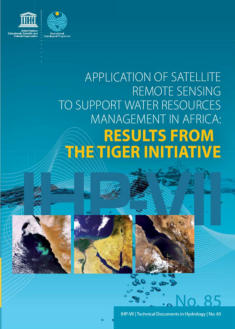

Authors: Per G. Reinhall, Peter H. Dahl
Underwater noise from impact pile driving was analyzed
using a finite element model for sound generation and a
parabolic equation model for propagation. The study
compared the results with measurements taken at the
Vashon Island ferry terminal near Seattle in November
2009 using a vertical line array. The tests revealed that the
primary underwater noise generated by impact driving is
from the Mach wave caused by the radial expansion of
the pile, which travels down the pile at supersonic speed
after impact.



Authors: Jim Laughlin
This technical report covers the underwater sound levels
recorded when a 30-inch steel pile was driven at the
Seattle Ferry Terminal on the 10th of February 2012. The
pile was driven at an angle next to the wing wall on the
north side of the slip. The project took place just west of
downtown Seattle, at the north end of Colman Dock,
Washington.


Author: Peter Dahl, Christ A. F. de Jong, Arthur N Popper
Impact pile driving is a method used to install piles in
marine and inland water construction projects using high-
energy impact hammers. This process, especially when
using hollow steel piles, generates high sound levels in
both water and air. As offshore wind projects continue to
expand, there is a growing concern about the impact of
construction-related underwater noise on marine life,
including mammal and fish populations.



Author:
Anthony D. Hawkins & Arthur N. Popper
When examining the impact of aquatic developments, it is
crucial to determine whether the underwater sounds
associated with them could harm fish. Risk assessment
helps to evaluate new and existing technologies to
prevent, control, or mitigate their impacts. It is necessary to
understand which sound levels could harm various fish
species and which levels are likely harmless. The
development and utilization of impact criteria for fish are
still in the early stages.





Publisher: U.S. Department of Health and Human Services
This document provides an overview and explanation of
the purpose, structure, and audience of toxicological
profiles prepared by the US Agency for Toxic Substances
and Disease Registry (ATSDR) in collaboration with the
Environmental Protection Agency (EPA). It outlines the
guidelines followed in creating these profiles, the type of
information included, the intended audience, and the
review process to ensure the accuracy and reliability of
the information presented.



Authors: S.L. Miller, D.W. Swanson, & M. Chiappone
This study, conducted in the Florida Keys National Marine
Sanctuary (FKNMS), assessed the differences in coverage,
density, and condition of benthic organisms between no-
fishing zones and reference sites. It highlights the spatial
variation at multiple scales and the importance of
considering a range of variables beyond common metrics,
such as coral cover.



Author: Anne Spurgeon
This study is a historical and analytical account of the
recognition and controversy surrounding "organic solvent
syndrome" as an occupational disease. It traces the
condition's origins, describes its symptoms and the
substances causing it, and discusses the varying
acceptance and rejection of the disease in different
countries, focusing on the skepticism and rejection in the
UK. The study also explores the social, cultural, and
professional factors that influence the recognition of
occupational diseases and examines why organic solvent
syndrome was not widely accepted in Britain despite its
recognition elsewhere.



Authors: John A S Ross, Sean Semple, Rodger Duffin, Frank
Kelly, Joerg Feldmann, & Andrea Raab
This report analyzes particle size, concentration, and
composition and assesses the dust's toxicity. The findings
highlight the dust's presence of various metals and non-
metallic substances, its nanoparticulate nature, and its
potential oxidative and inflammatory effects on human
lung cells. The authors also underscore the importance of
appropriate measurement techniques and respiratory
protection for workers involved in hyperbaric welding.

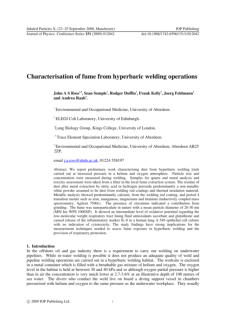

Authors: A Fernández, E. Sierra, V. Martín, M. Méndez, S.
Sacchini, Y. Bernaldo de Quirós, M. Andrada, M.
Rivero, O. Quesada, M. Tejedor, & Arbelo
This article discusses an incident involving the stranding of
Ziphius cavirostris (Cuvier's beaked whales) in the Canary
Islands in July 2004. It describes the circumstances
surrounding the stranding, including the use of high-
intensity mid-frequency sonar during international naval
exercises, the results of necropsies performed on the
stranded whales, and the subsequent establishment of an
anti-sonar moratorium in the Canary Islands, highlighting
the correlation between the use of sonar and the mass
stranding event, as well as the measures taken to prevent
future occurrences.



Authors:
John A. S. Ross, Jennifer I. MacDiarmid, Sean Semple,
Stephen J. Watt, Gill Moir, George Henderson
This study investigated the health-related quality of life and
cognitive symptomatology among three groups of male
workers: professional divers who had worked as welders,
professional welders who had not dived, and offshore oil
field workers who had neither dived nor welded. Its
purpose was to assess whether there was any association
between cognitive symptoms and exposure to welding
fumes or diving experience. The results indicate that
cognitive symptomatology is not significantly related to
either welding fume exposure or diving experience, and
the levels of cognitive symptoms in all groups were within
normative values.



Authors: Alain Michel Jules Norro, Bob Rumes, and Steven
Johan Degraer
This study analyzes the underwater noise generated
during the piling activities of steel monopiles and jacket
pinpiles in offshore wind farms in the Belgian part of the
North Sea to quantify and compare the noise levels, sound
exposure levels, and spectra for both types of piling, and to
assess their impact on marine life, specifically the harbour
porpoise Phocoena phocoena.


Author: Kenneth P. Sebens, Giacomo Bernardi, Mark R.
Patterson, and Deron Burkepile
This article highlights the advancements in coral reef
research facilitated by the advent of scuba diving and
associated underwater technologies. It emphasizes how
these technologies have significantly enhanced the
understanding of various aspects of coral biology and
coral reef ecosystems and how they continue to provide
valuable insights into the impact of changing ocean
conditions on corals and reefs.


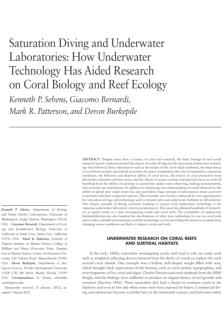

Author: J. Fredrik Lindgren, Ida-Maja Hassellöv, Hanna
Landquis, & Ingela Dahllöf
This study examined the development of tolerance to
polycyclic aromatic hydrocarbons (PAHs) in marine
microbes over 90 days. It focused on the effects of PAH
exposure on nitrification and denitrification processes and
changes in microbial community composition. The results
indicate that marine microbes developed tolerance to
PAHs, affecting nitrification efficiency and altering nitrifying
bacteria proportions. That highlights the importance of
considering tolerance development in environmental
monitoring and the potential impacts on marine microbial
health and ecosystem functions.



Authors:
Frank E. Muller-Karger, Patricia Miloslavich, Nicholas J. Bax ,
Samantha Simmons, Mark J. Costello, Isabel Sousa Pinto,
Gabrielle Canonico, Woody Turner, Michael Gill , Enrique
Montes , Benjamin D. Best, Jay Pearlman, Patrick Halpin,
Daniel Dunn , Abigail Benson, Corinne S. Martin, Lauren V.
Weatherdon, Ward Appeltans , Pieter Provoost, Eduardo
Klein, Christopher R. Kelble, Robert J. Miller, Francisco P.
Chavez, Katrin Iken, Sanae Chiba, David Obura, Laetitia M.
Navarro, Henrique M. Pereira, Valerie Allain, Sonia Batten,
Lisandro Benedetti-Checchi, J. Emmett Duffy, Raphael M.
Kudela, Lisa-Maria Rebelo, Yunne Shin, & Gary Geller
This document emphasizes the need for coordinated
efforts between various global initiatives and
organizations, such as the Global Ocean Observing
System (GOOS) and the Group on Earth Observations
Biodiversity Observation Network (GEO BON), to
streamline marine observation programs.



Authors: Stefano Goffredo, Corrado Piccinetti, and
Francesco Zaccanti
This study involved recruiting and training recreational
scuba divers to report seahorse sightings, using a specially
formulated questionnaire. It highlights the importance of
population monitoring for conservation purposes due to
habitat degradation and overexploitation. It also discusses
the findings of the study, including the abundance and
distribution of seahorses, preferred habitats, and the role
of divers in contributing to scientific data collection and
reducing costs. The study concludes by suggesting that
recreational divers and other resource users can actively
participate in marine environment monitoring



Publisher:
Jacqueline Michel, Trevor Gilbert, Dagmar Schmidt Etkin,
Robert Urban, Jon Waldron and Charles T. Blocksidge
This document analyzes the risks and issues associated
with oil pollution from sunken wrecks to raise awareness
about the potential environmental threats posed by these
wrecks and discusses the complexities involved in
addressing these threats, including regulatory, financial,
and technological challenges. It proposes considerations
for mitigating these risks, such as developing a worldwide
database of potentially polluting wrecks, evaluation of
regulatory frameworks, assessment of technological
feasibility for oil removal, and the need for systematic risk
assessment and prioritization of oil removal efforts.



Authors: Deborah French McCay , Danielle Reich ,
Jacqueline Michel , Dagmar Schmidt Etkin , Lisa
Symons , Doug Helton and John Wagner
This presentation, designed to be used on a large screen,
describes a probabilistic modeling analysis conducted to
evaluate the potential environmental and socioeconomic
impacts of oil spills from sunken vessels in U.S. waters. It
aims to identify high-risk vessels for potential salvage
operations and assist decision-makers in planning
response strategies, such as equipment deployment and
resource protection, outlining oil spill scenarios and the
probability and magnitudes of impacts.



Author: Ian D. MacLeod
This study focuses on the corrosion of WWII shipwrecks
resulting from Operation Hailstone in Chuuk Lagoon. It
involves a series of measurements to understand how
various environmental factors affect the corrosion rates of
materials like cast iron and mild steel in these shipwrecks.
In addition, the study highlights the conservation
management challenges posed by bunker fuel in the
wrecks.



Author:
James P. Delgado, Lisa C. Symons, Kelley Elliott, Frank
Cantelas, and Robert V. Schwemmer
This document relates a collaborative effort by NOAA and
The Boeing Company to conduct a deep-water
archaeological survey of the USS Independence shipwreck
in the Monterey Bay National Marine Sanctuary to provide
details about the survey's findings, which confirmed the
shipwreck's identity and assessed its condition, revealing
no detectable levels of radioactivity. Additionally, it
addresses public concern and media speculation
regarding potential pollution risks, suggesting that these
concerns may be exaggerated based on current evidence
and declassified reports.



Authors:
Hanna Landquist, Lars Rosén, Andreas Lindhe, and Ida-
Maja Hassellöv
This document describes a holistic risk assessment method
for evaluating the environmental risks posed by potentially
polluting shipwrecks that introduces a comprehensive
approach known as VRAKA, which combines the
probability of hazardous substance discharge with the
potential environmental consequences. It also outlines the
utility of this method in supporting decision-making and
prioritizing risk mitigation measures for shipwrecks.



Publisher: The Russian Academy of Sciences
This paper aims to inform readers about the conference's
focus on climate change indicators in marine ecosystems,
the development of methods for the prevention and
assessment of natural and human-made disasters, and the
facilitation of public discussion and involvement of the
academic and commercial sectors. It also specifies the
intended audience for the publication, which includes
oceanographers, marine biologists, environmental
monitoring experts, and students in related fields.



Authors:
Christian Katlein, Martin Schiller, Hans J. Belter, Veronica
Coppolaro, David Wenslandt, and Marcel Nicolaus
This paper intends to inform the scientific community and
interested parties about the development and capabilities
of a new remotely operated vehicle (ROV) designed for
interdisciplinary research in polar sea ice environments. It
highlights the importance of observing climate and
ecosystem changes in polar regions, describes the
technical features and operational capabilities of the ROV,
and demonstrates its effectiveness through data from a
campaign in the Arctic.













